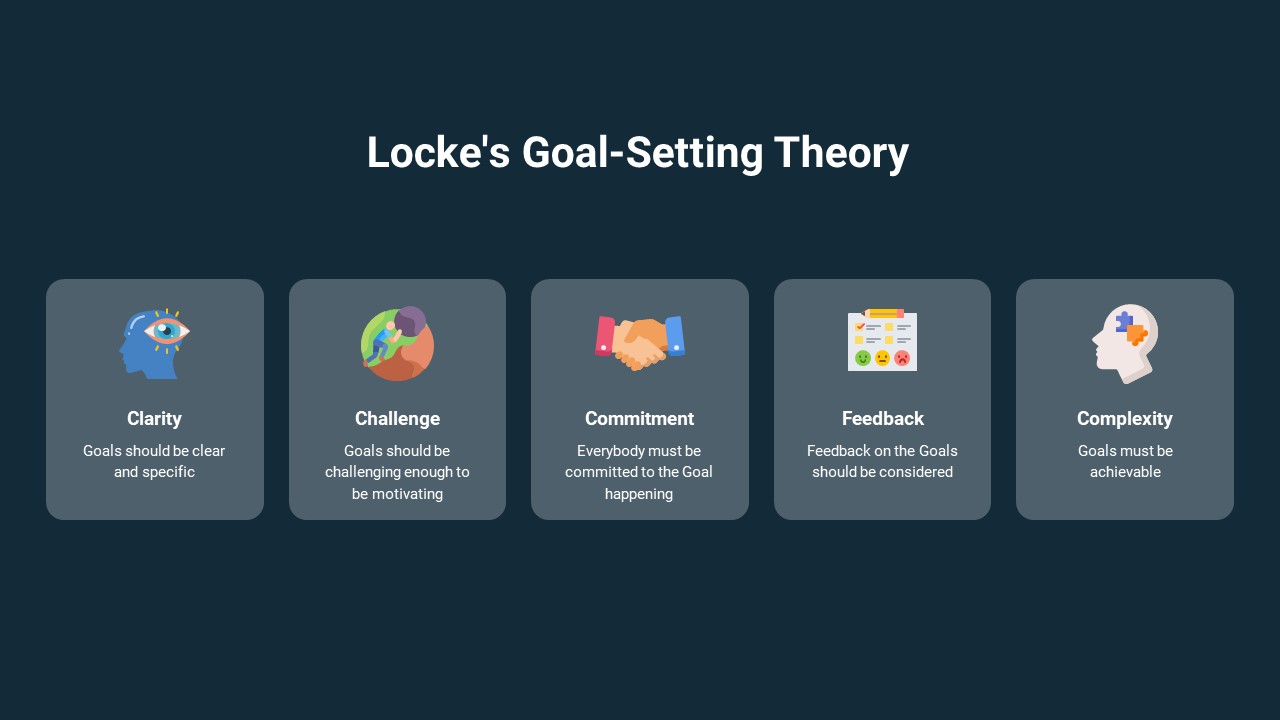Goal Setting Theory, developed by psychologists Edwin Locke and Gary Latham in the 1960s, is a psychological framework that explores the impact of setting and achieving goals on individual and organizational performance. This theory posits that specific and challenging goals lead to higher levels of motivation and performance compared to vague or easy-to-achieve goals. Over the years, Goal Setting Theory has gained widespread recognition and has been extensively applied in various fields, including psychology, management, and human resources.
Key Principles of Goal Setting Theory:
- Clarity and Specificity:
- The theory emphasizes the importance of setting clear and specific goals. Ambiguous or general objectives lack the motivational power that comes with a well-defined target. Employees are more likely to be motivated when they have a clear understanding of what is expected of them.
- Challenge and Difficulty:
- Goals that are challenging but achievable are central to the theory. A balance must be struck between setting objectives that stretch individuals or teams beyond their current capabilities and ensuring that the goals are within reach. The difficulty of the goal should inspire effort and commitment.
- Commitment:
- Goal Setting Theory asserts that individuals must be committed to the goals they set. When individuals are involved in the goal-setting process, they are more likely to be committed to achieving those goals. This commitment increases motivation and perseverance in the face of obstacles.
- Feedback:
- Regular feedback is essential for the effectiveness of Goal Setting Theory. Feedback provides individuals with information about their progress, allowing for adjustments and improvements. Positive feedback reinforces the commitment to goals, while constructive feedback aids in refining strategies.
- Task Complexity:
- The complexity of the task at hand influences the effectiveness of goal setting. For simple tasks, specific and challenging goals are more motivating. However, for complex tasks, a gradual approach with intermediate sub-goals may be more effective.
Understanding Goal Setting Theory:
The core principles of Goal Setting Theory revolve around setting clear, specific, and challenging goals that are achievable within a defined timeframe. The theory emphasizes the importance of feedback, task complexity, and commitment to achieving these goals. When applied effectively, Goal Setting Theory can enhance employee performance, satisfaction, and overall organizational outcomes.
HR Use Cases for Goal Setting Theory:
- Performance Management:
- Setting SMART Goals: HR professionals can use Goal Setting Theory to guide employees in establishing SMART (Specific, Measurable, Achievable, Relevant, Time-bound) goals during performance appraisal processes. Clear and challenging goals help employees understand expectations and motivate them to excel in their roles.
- Regular Feedback Sessions: Implementing regular feedback sessions ensures that employees receive constructive input on their progress. This allows for course correction, reinforces positive behavior, and fosters a continuous improvement mindset.
- Employee Development:
- Career Path Planning: HR can collaborate with employees to set career development goals aligned with organizational objectives. This not only empowers employees to take charge of their professional growth but also aligns individual aspirations with the company’s long-term vision.
- Skill Enhancement Programs: By incorporating Goal Setting Theory into training and development programs, HR can encourage employees to set skill-specific goals. Whether it’s mastering a new technology or acquiring leadership skills, setting clear targets enhances the effectiveness of learning initiatives.
- Employee Engagement:
- Team Building Goals: HR can leverage Goal Setting Theory to establish collaborative team goals. Encouraging employees to work towards common objectives fosters a sense of camaraderie, enhances teamwork, and contributes to a positive work culture.
- Recognition and Rewards Programs: Aligning individual and team goals with recognition and rewards programs can motivate employees to strive for excellence. Acknowledging and celebrating achievements reinforces the connection between effort, performance, and recognition.
- Organizational Performance:
- Strategic Alignment: HR professionals can ensure that individual and team goals are aligned with organizational objectives. This strategic alignment ensures that every employee’s efforts contribute to the overall success of the company.
- Key Performance Indicators (KPIs): Establishing and monitoring key performance indicators tied to specific goals allows HR to measure progress and identify areas for improvement. This data-driven approach enhances decision-making processes and facilitates continuous organizational growth.
Conclusion:
Incorporating Goal Setting Theory into HR practices provides a structured and effective way to drive individual and organizational success. By setting clear goals, providing feedback, and aligning objectives with organizational strategies, HR professionals can harness the power of Goal Setting Theory to create a motivated, engaged, and high-performing workforce. As organizations evolve and face new challenges, the application of Goal Setting Theory in HR remains a dynamic and essential strategy for achieving sustained success.











